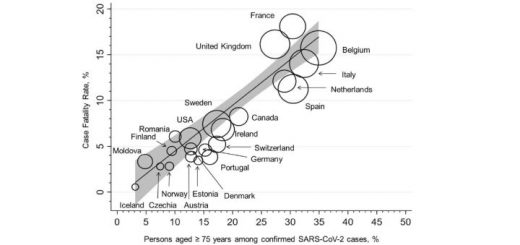Top 10 Special: Epidemiology
Later this month, we will publish the 5th COVID Reference Edition. Find 10 papers we will include in the Epidemiology chapter. The topics: “variolation”; introduction of SARS-CoV-2 in Europe, North America and Brazil; seroprevalence data from Mumbai and Manaus; frontline healthcare workers in the US and in London; school openings; the second wave.
Changing the course of the pandemic
Bielecki M, Züst R, Siegrist D, et al. Social distancing alters the clinical course of COVID-19 in young adults: A comparative cohort study. Clin Inf Dis, June 29, 2020. Full-text: https://doi.org/10.1093/cid/ciaa889 l (Important)
Might reducing the viral SARS-CoV-2 inoculum not only reduce the probability of infection but also favor an asymptomatic infection while still generating immunity? That was the suggestion by Michel Bielecki et al. in June 2020 (Bielecki 2020), later developed later by Monica Gandhi and George W. Rutherford (Ghandi 2020). If universal facial masking might help reduce the severity of disease and ensure that a greater proportion of new infections are asymptomatic, it would be a giant leap to pandemic control. If universal masking could be proved to be a form of “variolation” (inoculation), it would be the finding of the year.
SARS-CoV-2 Introduction
Emergence in Europe and North America
Worobey M, Pekar J, Larsen BB, et al. The emergence of SARS-CoV-2 in Europe and North America. Science 2020, published 10 September. Full-text: https://doi.org/10.1126/science.abc8169
Despite the early successes in containment, SARS-CoV-2 eventually took hold in both Europe and North America during the first two months of 2020: first in Italy around the end of January, then in Washington State around the beginning of February, and followed by New York City later that month (Worobey 2020; see also Figure 6).
Brazil
Candido DS, Claro M, de Jesus JG, et al. Evolution and epidemic spread of SARS-CoV-2 in Brazil. Science 23 Jul 2020:eabd2161. Full-text: https://doi.org/10.1126/science.abd2161
Sequencing of hundreds of genomes showed that more than 100 international virus introductions in Brazil with 76% of Brazilian strains falling into three clades that were introduced from Europe between 22 February and 11 March 2020 (Candido 2020).
Seroprevalance
Mumbai, India
Kolthur-Seetharam U, Shah D, Shastri J, Juneja S, Kang G, Malani A, Mohanan M, Lobo GN, Velhal G, Gomare M. SARS-CoV2 Serological Survey in Mumbai by NITI-BMC-TIFR. Tata Institute of Fundamental Research (TIFR) 2020, published 29 June. Full-text: https://www.tifr.res.in/TSN/article/Mumbai-Serosurvey%20Technical%20report-NITI.pdf
In a cross-sectional survey in Mumbai, India, the prevalence of SARS-CoV-2 infection in three areas in Mumbai (called ‘wards’) was around 57% in the slum areas of Chembur, Matunga and Dahisar, and 16% in neighboring non-slums (Kolthur-Seetharam 2020). If these data are confirmed, some Mumbai areas would soon reach herd immunity and could return to a pre-COVID way of life. For many countries in the world, this would be the best piece of news since the beginning of the pandemic.
Manaus, Brazil
Buss LF, Prete Jr CA, Abrahim CMM, et al. COVID-19 herd immunity in the Brazilian Amazon. medRxiv 2020, posted 21 September. Full-text: https://doi.org/10.1101/2020.09.16.20194787
Will this paper be accepted by the peers? As much as 66% of the population of Manaus (two million people), Brazil, could have been infected with SARS-CoV-2. Ester Sabino, Lewis Buss and colleagues show that the transmission of SARS-CoV-2 in Manaus increased quickly during March and April and declined more slowly from May to September. In June, one month following the epidemic peak, 44% of the population was seropositive for SARS-CoV-2. After correcting for confounding factors, the authors estimate the epidemic size to be 66% by early August 2020.
Remember: herd immunity is defined as the proportion of a population that must be immune to an infectious disease, either by natural infection or vaccination, such that new cases decline and R0 falls below 1 (see also https://www.nature.com/articles/d41586-020-02009-w).
Frontline healthcare workers: US
Self WH, Tenforde MW, Stubblefield WB, et al. Seroprevalence of SARS-CoV-2 Among Frontline Health Care Personnel in a Multistate Hospital Network — 13 Academic Medical Centers, April–June 2020. MMWR. Full-text: http://dx.doi.org/10.15585/mmwr.mm6935e2
Many cases appear to go undetected: among 3,248 HCWs who routinely cared for COVID-19 patients in 13 US academic medical centers from February 1, 2020, 194 (6%) had evidence of previous SARS-CoV-2 infection, with considerable variation by location that generally correlated with community cumulative incidence. Among 194 participants who had SARS-CoV-2 antibodies, 56 (29%) did not recall any symptoms consistent with an acute viral illness in the preceding months and 133 (69%) did not have a previous positive test result demonstrating an acute SARS-CoV-2 infection. Prevalence of SARS-CoV-2 antibodies was lower among personnel who reported always wearing a face covering while caring for patients (6%), compared with those who did not (9%).
Frontline healthcare workers: London
Houlihan CF, Vora N, Byrne T, et al. Pandemic peak SARS-CoV-2 infection and seroconversion rates in London frontline health-care workers. Lancet July 09, 2020. Full-text: https://doi.org/10.1016/S0140-6736(20)31484-7
High-risk frontline healthcare workers (HCV) are really at high risk. In a prospective cohort study in an acute National Health Service hospital trust in London, 25% of HCWs were already seropositive at enrolment (26 March to 8 April) and a further 20% became seropositive within the first month of follow-up (Houlihan 2020). Most infections occurred between March 30 and April 5, the week with the highest number of new cases in London.
School Openings
Cheng SY, Wang J, Shen AC, et al. How to Safely Reopen Colleges and Universities During COVID-19: Experiences From Taiwan. Ann Int Med 2020, Jul 2. Full-text: https://doi.org/10.7326/M20-2927
Taiwan is one of the few countries where schools are functioning normally. To secure the safety of students and staff, the Ministry of Education in Taiwan established general guidelines, including a combination of strategies such as – our future? – active campus-based screening and access control; school-based screening and quarantine protocols; student and faculty quarantine when warranted; mobilization of administrative and health center staff; regulation of dormitories and cafeterias; and reinforcement of personal hygiene, environmental sanitation, and indoor air ventilation practices (Cheng SY 2020). Depressing (un monde de con), but probably necessary.
Second Wave
NCOMG. The national COVID-19 outbreak monitoring group. COVID-19 outbreaks in a transmission control scenario: challenges posed by social and leisure activities, and for workers in vulnerable conditions, Spain, early summer 2020. Eurosurveillance Volume 25, Issue 35, 03/Sep/2020. Full-text: https://www.eurosurveillance.org/content/10.2807/1560-7917.ES.2020.25.35.2001545
From mid-June to 2 August, excluding single household outbreaks, 673 outbreaks were notified in Spain (NCOMG 2020). There were two main settings where over 55% of active outbreaks (303/551) and over 60% (3,815/6,208) of active outbreak cases originated: First, social settings such as family gatherings or private parties (112 outbreaks, 854 cases), followed by those linked to leisure venues such as bars, restaurants, or clubs (34 outbreaks, over 1,230 cases). Second, occupational settings (representing 20% of all active outbreaks), mainly among workers in the fruit and vegetable sector (31 outbreaks and around 500 cases) and workers at slaughterhouses or meat processing plants (12 outbreaks and around 360 cases).
Future Pandemics
Rigorous wildlife disease surveillance
Watsa M. Rigorous wildlife disease surveillance. Science 10 Jul 2020, 369: 145-147. Full-text: https://doi.org/10.1126/science.abc0017
Emerging infectious diseases (EID) associated with the wildlife trade remain the largest unmet challenge of current disease surveillance efforts. International or national conventions on pathogen screening associated with animals, animal products or their movements are urgently needed (Watsa 2020). Internationally recognized standard for managing wildlife trade on the basis of known disease risks should be established.



